Podcast
Questions and Answers
What was the main cause of the Civil War between King Charles I and Parliament?
What was the main cause of the Civil War between King Charles I and Parliament?
- King Charles I's refusal to dissolve the monarchy
- Parliament's insistence on the king's complete power
- Parliament's demand for new taxes (correct)
- Cromwell's dictatorship
What significant event happened in 1649 related to King Charles I?
What significant event happened in 1649 related to King Charles I?
- He was convicted and executed for treason (correct)
- He was restored to the throne
- He dissolved Parliament
- He established a military dictatorship
Which king was invited back to the throne in 1660 following a period of military dictatorship?
Which king was invited back to the throne in 1660 following a period of military dictatorship?
- Oliver Cromwell
- James II
- William of Orange
- Charles II (correct)
What was the primary mistake made by James II that led to his removal?
What was the primary mistake made by James II that led to his removal?
What document was passed by Parliament in 1689 that limited the powers of the Crown?
What document was passed by Parliament in 1689 that limited the powers of the Crown?
What change occurred in the early 18th century regarding the leadership within the British government?
What change occurred in the early 18th century regarding the leadership within the British government?
In the context of the British constitutional monarchy, what role does the Prime Minister primarily play?
In the context of the British constitutional monarchy, what role does the Prime Minister primarily play?
What major development occurred due to the Bill of Rights regarding the monarchy?
What major development occurred due to the Bill of Rights regarding the monarchy?
Flashcards
The English Civil War (1642-1660)
The English Civil War (1642-1660)
The first fight between the English Crown and Parliament, caused by disputes over power and taxation.
The Restoration of the Monarchy (1660-1688)
The Restoration of the Monarchy (1660-1688)
The period after the English Civil War, marked by the return of the monarchy under Charles II, with the King's powers restored but a growing need for cooperation with Parliament.
The Glorious Revolution (1688-1689)
The Glorious Revolution (1688-1689)
A significant event that saw King James II deposed and replaced by William and Mary, who agreed to share power with Parliament, establishing a constitutional monarchy.
The Bill of Rights (1689)
The Bill of Rights (1689)
Signup and view all the flashcards
Constitutional Monarchy
Constitutional Monarchy
Signup and view all the flashcards
Prime Minister
Prime Minister
Signup and view all the flashcards
The Cabinet
The Cabinet
Signup and view all the flashcards
Evolution of the British Constitutional Monarchy
Evolution of the British Constitutional Monarchy
Signup and view all the flashcards
Study Notes
The Civil War and the Commonwealth (1642–1660)
- First conflict between the Crown and Parliament
- Early 17th century: Parliament challenged the monarch's power, demanding more control over crucial issues, particularly taxation.
- King Charles I resisted, leading to the English Civil War in 1642.
- The King's execution for treason in 1649 followed.
- Oliver Cromwell established a military dictatorship.
The Restoration of the Monarchy (1660–1688)
- Cromwell's rule caused disillusionment, with a desire for a stable government.
- Charles II, the executed king's son, was restored to the throne in 1660.
- Charles II, generally worked cooperatively with Parliament, learning from his father's mistakes.
The Glorious Revolution (1688–1689)
- James II, Charles II's brother, tried to promote Catholicism, a major unpopularity, alarming Parliament.
- Parliament removed James II from the throne, worried about the possible re-establishment of Catholicism.
- William of Orange and Mary were invited to rule jointly.
- William and Mary accepted Parliament's conditions, marking a significant shift in power.
- The Bill of Rights (1689), limited the Crown's powers and increased Parliament's authority.
- It established a hereditary monarchy, but with legislative approval required for most decisions and regular elections for Commons members.
Development of the Constitutional Monarchy (18th Century)
- The Bill of Rights did not create specific governing institutions.
- King's ministers handled day-to-day governance.
- Ministers needed support from the House of Commons majority to succeed.
- This led to the Prime Minister, as the chief minister.
- The Prime Minister advised the monarch on appointments, forming a Cabinet of leading ministers.
- The fundamental framework of the British constitutional monarchy remained consistent, despite evolving political landscape and democratic expansions.
Studying That Suits You
Use AI to generate personalized quizzes and flashcards to suit your learning preferences.




